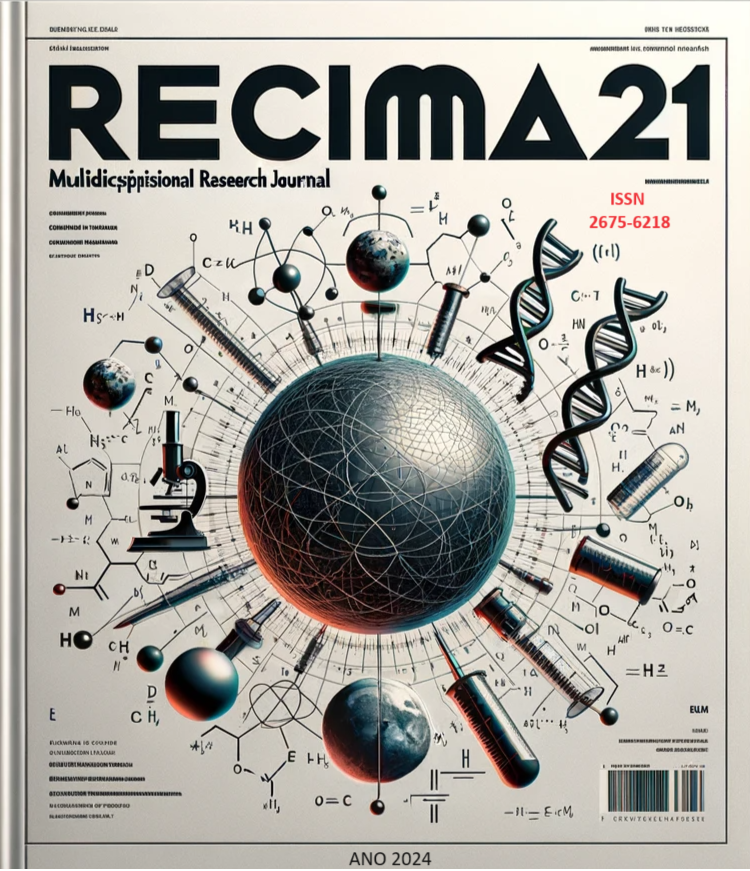POINT OF CARE ULTRASOUND AND ACUTE AORTIC DISSECTION
DOI:
https://doi.org/10.47820/recima21.v5i9.5754Keywords:
Early diagnosis. Emergency. Imaging diagnosis.Abstract
Point of care ultrasoud (POCUS) has emerged as an essential tool for the rapid and effective assessment of several critical conditions in the hospital environment, including acute aortic dissection. Objective: to review the application of bedside ultrasound in the context of acute aortic dissection. Materials and methods: this is an integrative review, in which the guiding question was “How does the use of bedside ultrasound for the diagnosis of acute aortic dissection in patients compare to the use of standard diagnostic methods in terms of diagnostic accuracy, time to diagnosis, mortality rate, and associated complications?”. The search for articles was carried out in PubMed using the terms “point of care ultrasound" and "acute aortic dissection”, combined with each other by Boolean operators. Results and discussion: Since the diagnosis needs to be made quickly, especially in unstable patients, transthoracic echocardiography with bedside ultrasound is a rapid and noninvasive imaging study that should be used to aid in the diagnosis of acute aortic dissection. POCUS has been shown to significantly reduce the time to diagnosis of these pathologies in different studies, with high specificity and sensitivity to diagnose the disease, and reduced mortality and follow-up mortality. Conclusion: We conclude that there is a great advantage in using POCUS in the emergency department for the diagnosis of fatal pathologies, as it is fast, portable, noninvasive and repeatable.
Downloads
References
ALFOTI, Bushra Othman Omar et al. Utilization of Point-of-Care Ultrasound (POCUS) in Emergency and Critical Care: Role of Nursing for Enhancing Diagnostic Accuracy and Efficiency-Systematic Review. Egyptian Journal of Chemistry, v. 67, n. 13, p. 705-716, 2024. DOI: https://doi.org/10.21608/ejchem.2024.297100.9851
DAVIS, Christopher B.; KENDALL, John L. Emergency bedside ultrasound diagnosis of superior mesenteric artery dissection complicating acute aortic dissection. The Journal of Emergency Medicine, v. 45, n. 6, p. 894-896, 2013. DOI: https://doi.org/10.1016/j.jemermed.2013.04.025
DE SOUSA, Luís Manuel Mota et al. A metodologia de revisão integrativa da literatura em enfermagem. Revista investigação em enfermagem, v. 21, n. 2, p. 17-26, 2017.
DOTE, Hisashi et al. Acute aortic dissection with highly compressed true lumen: unanticipated pitfall of point-of-care ultrasonography. BMJ Case Reports CP, v. 14, n. 3, p. e239328, 2021. DOI: https://doi.org/10.1136/bcr-2020-239328
ERCOLE, Flávia Falci; MELO, Laís Samara de; ALCOFORADO, Carla Lúcia Goulart Constant. Revisão integrativa versus revisão sistemática. Reme: Revista Mineira de Enfermagem, v. 18, n. 1, p. 09-11, 2014. DOI: https://doi.org/10.5935/1415-2762.20140001
GAWINECKA, Joanna; SCHÖNRATH, Felix; VON ECKARDSTEIN, Arnold. Acute aortic dissection: pathogenesis, risk factors and diagnosis. Swiss medical weekly, v. 147, p. w14489, 2017. DOI: https://doi.org/10.4414/smw.2017.14489
GIBBONS, R. et al. 364 point-of-care ultrasound for the detection of aortic dissections in the emergency department. Annals of Emergency Medicine, v. 70, n. 4, p. S143, 2017. DOI: https://doi.org/10.1016/j.annemergmed.2017.07.334
KAELEY, Nidhi et al. Atypical presentation of aortic dissection in a young female and the utility of point-of-care ultrasound in identifying aortic dissection in the emergency department. Cureus, v. 14, n. 7, 2022. DOI: https://doi.org/10.7759/cureus.27236
LEVY, David et al. Aortic Dissection. [Updated 2023 Apr 23]. In: StatPearls [Internet]. Treasure Island (FL): StatPearls Publishing; 2024 Jan.
LÓPEZ, Vladimir Cárdenas; BLANCO, Pablo. Acute Type A Aortic Dissection Diagnosed by POCUS in a 29-year-old Man. POCUS journal, v. 8, n. 2, p. 118, 2023. DOI: https://doi.org/10.24908/pocus.v8i2.16533
MAHALINGAM, Sasikumar et al. Stanford-A Aortic Dissection Presenting as a Triple Mimic and Role of Point of Care Ultrasound in Deciphering It. Journal of Emergencies, Trauma, and Shock, v. 14, n. 3, p. 187-189, 2021. DOI: https://doi.org/10.4103/JETS.JETS_134_20
MARTINEZ, Ernesto Calderon et al. Point-of-care ultrasound for the diagnosis of frequent cardiovascular diseases: a review. Cureus, v. 15, n. 12, 2023.
MENDES, Karina Dal Sasso; SILVEIRA, Renata Cristina de Campos Pereira; GALVÃO, Cristina Maria. Revisão integrativa: método de pesquisa para a incorporação de evidências na saúde e na enfermagem. Texto & contexto-enfermagem, v. 17, p. 758-764, 2008. DOI: https://doi.org/10.1590/S0104-07072008000400018
NIENABER, Christoph A. et al. Aortic dissection. Nature reviews Disease primers, v. 2, n. 1, p. 1-18, 2016. DOI: https://doi.org/10.1038/nrdp.2016.53
PINTO-COELHO, Luís. How artificial intelligence is shaping medical imaging technology: A survey of innovations and applications. Bioengineering, v. 10, n. 12, p. 1435, 2023. DOI: https://doi.org/10.3390/bioengineering10121435
SAEID, Hafsah et al. The role of point-of-care ultrasound in the emergency department: the case of a contained rupture of the ascending aorta due to type a dissection causing subacute cardiac tamponade. CASE, v. 6, n. 6, p. 275-280, 2022. DOI: https://doi.org/10.1016/j.case.2022.05.005
THOMAS, Kristina; AMR, Omar. Use of Point‐of‐Care Ultrasound for Early Identification of Acute Aortic Root Dissection. Case Reports in Critical Care, v. 2022, n. 1, p. 7166230, 2022. DOI: https://doi.org/10.1155/2022/7166230
WANG, Yuan et al. Early screening for aortic dissection with point‐of‐care ultrasound by emergency physicians: a prospective pilot study. Journal of Ultrasound in Medicine, v. 39, n. 7, p. 1309-1315, 2020. DOI: https://doi.org/10.1002/jum.15223
ZARAMA, Virginia; ARANGO-GRANADOS, María C.; CRISTANCHO, Luis A. Bustamante. Importance of multiple-window assessment for the diagnosis of ascending aortic dissection using point-of-care ultrasound: report of three cases. Clinical Practice and Cases in Emergency Medicine, v. 3, n. 4, p. 333, 2019. DOI: https://doi.org/10.5811/cpcem.2019.6.43245
Downloads
Published
License
Copyright (c) 2024 RECIMA21 - Revista Científica Multidisciplinar - ISSN 2675-6218

This work is licensed under a Creative Commons Attribution 4.0 International License.
Os direitos autorais dos artigos/resenhas/TCCs publicados pertecem à revista RECIMA21, e seguem o padrão Creative Commons (CC BY 4.0), permitindo a cópia ou reprodução, desde que cite a fonte e respeite os direitos dos autores e contenham menção aos mesmos nos créditos. Toda e qualquer obra publicada na revista, seu conteúdo é de responsabilidade dos autores, cabendo a RECIMA21 apenas ser o veículo de divulgação, seguindo os padrões nacionais e internacionais de publicação.













